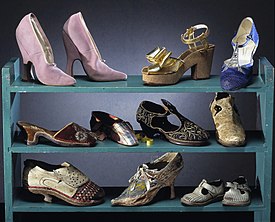
A shoe is an item of footwear intended to protect and comfort the human foot. Though the human foot can adapt to varied terrains and climate conditions, it is vulnerable, and shoes provide protection. Form was originally tied to function, but over time, shoes also became fashion items. Some shoes are worn as safety equipment, such as steel-toe boots, which are required footwear at industrial worksites.
Additionally, shoes have often evolved into many different designs, such as high heels, which are most commonly worn by women during fancy occasions. Contemporary footwear varies vastly in style, complexity and cost. Basic sandals may consist of only a thin sole and simple strap and be sold for a low cost. High fashion shoes made by famous designers may be made of expensive materials, use complex construction and sell for large sums of money. Some shoes are designed for specific purposes, such as boots designed specifically for mountaineering or skiing, while others have more generalized usage such as sneakers which have transformed from a special purpose sport shoe into a general use shoe.
Traditionally, shoes have been made from leather, wood or canvas, but are increasingly being made from rubber, plastics, and other petrochemical-derived materials.[1] Globally, the shoe industry is a $200 billion a year industry.[1] 90% of shoes end up in landfills, because the materials are hard to separate, recycle or otherwise reuse.[1]
- ^ a b c Hoskins, Tansy E. (2020-03-21). "'Some soles last 1,000 years in landfill': the truth about the sneaker mountain". The Guardian. Retrieved 2021-02-19.